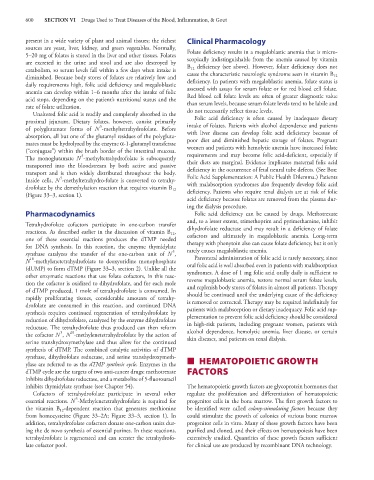Page 614 - Basic _ Clinical Pharmacology ( PDFDrive )
P. 614
600 SECTION VI Drugs Used to Treat Diseases of the Blood, Inflammation, & Gout
present in a wide variety of plant and animal tissues; the richest Clinical Pharmacology
sources are yeast, liver, kidney, and green vegetables. Normally,
5–20 mg of folates is stored in the liver and other tissues. Folates Folate deficiency results in a megaloblastic anemia that is micro-
are excreted in the urine and stool and are also destroyed by scopically indistinguishable from the anemia caused by vitamin
12
catabolism, so serum levels fall within a few days when intake is B deficiency (see above). However, folate deficiency does not
12
diminished. Because body stores of folates are relatively low and cause the characteristic neurologic syndrome seen in vitamin B
daily requirements high, folic acid deficiency and megaloblastic deficiency. In patients with megaloblastic anemia, folate status is
anemia can develop within 1–6 months after the intake of folic assessed with assays for serum folate or for red blood cell folate.
acid stops, depending on the patient’s nutritional status and the Red blood cell folate levels are often of greater diagnostic value
rate of folate utilization. than serum levels, because serum folate levels tend to be labile and
Unaltered folic acid is readily and completely absorbed in the do not necessarily reflect tissue levels.
proximal jejunum. Dietary folates, however, consist primarily Folic acid deficiency is often caused by inadequate dietary
5
of polyglutamate forms of N -methyltetrahydrofolate. Before intake of folates. Patients with alcohol dependence and patients
absorption, all but one of the glutamyl residues of the polygluta- with liver disease can develop folic acid deficiency because of
mates must be hydrolyzed by the enzyme α-1-glutamyl transferase poor diet and diminished hepatic storage of folates. Pregnant
(“conjugase”) within the brush border of the intestinal mucosa. women and patients with hemolytic anemia have increased folate
5
The monoglutamate N -methyltetrahydrofolate is subsequently requirements and may become folic acid-deficient, especially if
transported into the bloodstream by both active and passive their diets are marginal. Evidence implicates maternal folic acid
transport and is then widely distributed throughout the body. deficiency in the occurrence of fetal neural tube defects. (See Box:
5
Inside cells, N -methyltetrahydro-folate is converted to tetrahy- Folic Acid Supplementation: A Public Health Dilemma.) Patients
drofolate by the demethylation reaction that requires vitamin B with malabsorption syndromes also frequently develop folic acid
12
(Figure 33–3, section 1). deficiency. Patients who require renal dialysis are at risk of folic
acid deficiency because folates are removed from the plasma dur-
ing the dialysis procedure.
Pharmacodynamics Folic acid deficiency can be caused by drugs. Methotrexate
and, to a lesser extent, trimethoprim and pyrimethamine, inhibit
Tetrahydrofolate cofactors participate in one-carbon transfer
reactions. As described earlier in the discussion of vitamin B , dihydrofolate reductase and may result in a deficiency of folate
12
one of these essential reactions produces the dTMP needed cofactors and ultimately in megaloblastic anemia. Long-term
for DNA synthesis. In this reaction, the enzyme thymidylate therapy with phenytoin also can cause folate deficiency, but it only
5
synthase catalyzes the transfer of the one-carbon unit of N , rarely causes megaloblastic anemia.
10
N -methylenetetrahydrofolate to deoxyuridine monophosphate Parenteral administration of folic acid is rarely necessary, since
(dUMP) to form dTMP (Figure 33–3, section 2). Unlike all the oral folic acid is well absorbed even in patients with malabsorption
other enzymatic reactions that use folate cofactors, in this reac- syndromes. A dose of 1 mg folic acid orally daily is sufficient to
tion the cofactor is oxidized to dihydrofolate, and for each mole reverse megaloblastic anemia, restore normal serum folate levels,
of dTMP produced, 1 mole of tetrahydrofolate is consumed. In and replenish body stores of folates in almost all patients. Therapy
rapidly proliferating tissues, considerable amounts of tetrahy- should be continued until the underlying cause of the deficiency
drofolate are consumed in this reaction, and continued DNA is removed or corrected. Therapy may be required indefinitely for
synthesis requires continued regeneration of tetrahydrofolate by patients with malabsorption or dietary inadequacy. Folic acid sup-
reduction of dihydrofolate, catalyzed by the enzyme dihydrofolate plementation to prevent folic acid deficiency should be considered
reductase. The tetrahydrofolate thus produced can then reform in high-risk patients, including pregnant women, patients with
5
10
the cofactor N , N -methylenetetrahydrofolate by the action of alcohol dependence, hemolytic anemia, liver disease, or certain
serine transhydroxymethylase and thus allow for the continued skin diseases, and patients on renal dialysis.
synthesis of dTMP. The combined catalytic activities of dTMP
synthase, dihydrofolate reductase, and serine transhydroxymeth-
ylase are referred to as the dTMP synthesis cycle. Enzymes in the ■ HEMATOPOIETIC GROWTH
dTMP cycle are the targets of two anti-cancer drugs: methotrexate FACTORS
inhibits dihydrofolate reductase, and a metabolite of 5-fluorouracil
inhibits thymidylate synthase (see Chapter 54). The hematopoietic growth factors are glycoprotein hormones that
Cofactors of tetrahydrofolate participate in several other regulate the proliferation and differentiation of hematopoietic
5
essential reactions. N -Methylenetetrahydrofolate is required for progenitor cells in the bone marrow. The first growth factors to
the vitamin B -dependent reaction that generates methionine be identified were called colony-stimulating factors because they
12
from homocysteine (Figure 33–2A; Figure 33–3, section 1). In could stimulate the growth of colonies of various bone marrow
addition, tetrahydrofolate cofactors donate one-carbon units dur- progenitor cells in vitro. Many of these growth factors have been
ing the de novo synthesis of essential purines. In these reactions, purified and cloned, and their effects on hematopoiesis have been
tetrahydrofolate is regenerated and can reenter the tetrahydrofo- extensively studied. Quantities of these growth factors sufficient
late cofactor pool. for clinical use are produced by recombinant DNA technology.

